Trees Birds Mammals Fish Amphibians Reptiles
Wild Algarve
Bookshop
Laccaria bicolor (Maire) P.D. Orton - Bicoloured Deceiver
Phylum: Basidiomycota - Class: Agaricomycetes - Order: Agaricales - Family: Hydnangiaceae
Distribution - Taxonomic History - Etymology - Identification - Culinary Notes - Reference Sources
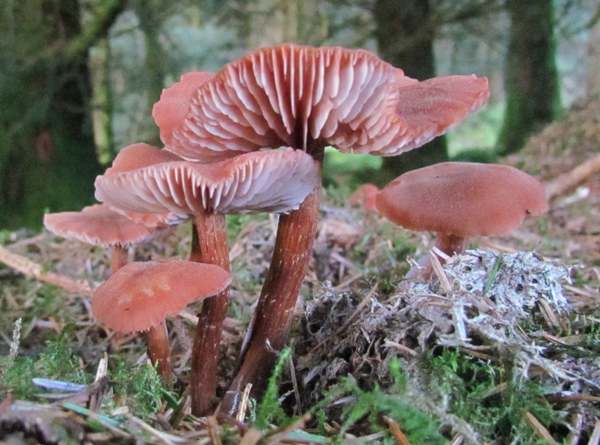
Treated as merely a variety of Deceiver until relatively recent times, Laccaria bicolor is distinguished from the more common Deceiver Laccaria laccata and Scurfy Deceiver Laccaria proxima by its stem, which has a lilac-coloured base but a tawny upper section.
Distribution
Rather uncommon and localised in Britain and Ireland, Laccaria bicolor occurs also throughout mainland Europe and in North America.
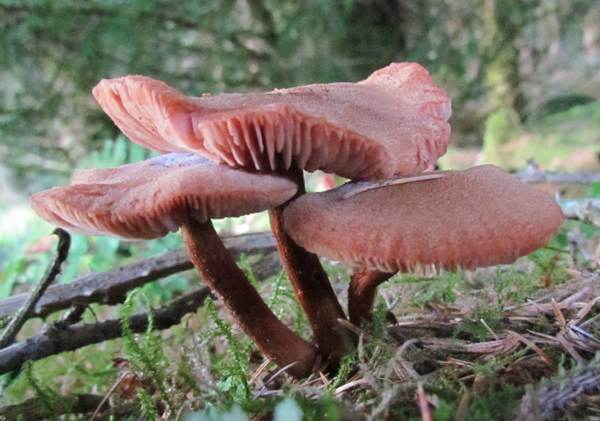
Taxonomic history
This woodland fungus was described in 1937 by the French mycologist René Maire (1878 - 1949) as a variety of the Deceiver and given the scientific name Laccaria laccata var. bicolor. Nearly a quarter of a century elapsed before British mycologist Peter Darbishire Orton (1916 - 2005) raised the status of this mushroom to species level, renaming it Laccaria bicolor.
Synonyms of Laccaria bicolor include Laccaria laccata var. bicolor Maire, and Laccaria proxima var. bicolor (Maire) Kühner & Romagn.
All Laccaria species are ectomycorrhizal fungi, forming symbiotic relationships with forest trees. Genetic research into Laccaria bicolor and other members of the little-understood family Hydnangiaceae is throwing new light on the complexities of these root-fungus relationships.
Etymology
The specific epithet bicolor is Latin and simply means 'being of two colours' - it's a two-tone toadstool.
Identification guide
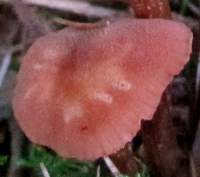 |
Cap
Bicolour Deceiver caps are 2 to 6cm in diameter, initially convex becoming
flat-topped at maturity, often with a depressed centre and a down-turned rim.
Hygrophanous: during wet weather young caps of Laccaria bicolor are deep tan
or reddish-brown, but during dry spells the caps become much
paler buff and eventually almost white. This colour change is a characteristic of fungi in this genus and the reason for their common name 'deceivers'. |
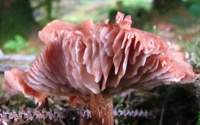 |
Gills
The deep, broad pinkish-lilac (when young) gills of the Bicoloured Deceiver are widely spaced and
interspersed with shorter gills; they are adnate or slightly decurrent. In normal autumn weather, before the caps fade the
tan gills begin losing their colour and become clay-lilac and then buff. This is because they get covered in
spores. (Surprisingly,
when you consider how dark the young gills are - the spores of this mushroom
are white.) |
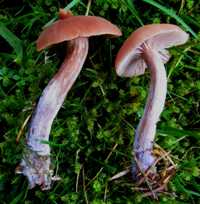
|
Stem
Laccaria bicolor stems are 5 to 10mm in diameter and 5 to 14cm tall. The tough, fibrous stems are more 'hairy' towards the base, where the lower part of the stems of fresh young specimens (left) are covered in a lilac-coloured mycelial down. Unfortunately, this lilac colouring soon fades, so that identification of older, more mature fruitbodies is more difficult. (The basidia of some Laccaria species are two-spored while others are four-spored, but to see these features you need to be skilled in using a high-powered microscope.) |
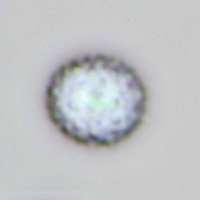 |
Spores
7 to 9.5 x 6 to 8.5μm, subglobose to broadly ellipsoidal, very spiny (spines up to 1.8μm tall), thick-walled, hyaline.
Spore print
White.
Basidia
Four-spored. |
Odour/taste |
Not distinctive. |
Habitat & Ecological role |
Ectomycorrhizal with pines and other conifers, Bicolour Deceivers are found among leaf litter in all kinds of mixed woodland
and on heaths; they favour neutral to acidic soils. |
Season |
June to November in Britain and Ireland. |
Similar species |
Laccaria laccata appears in similar habitats but it does not have lilac down on the lower part of its stem.
Laccaria amethystina is a violet coloured member of the same
genus; once it has dried out it becomes pale buff and virtually
indistinguishable from dried out specimens of Laccaria bicolor and Laccaria laccata. |
Culinary Notes
The Bicoloured Deceiver Laccaria bicolor is an edible mushroom. The caps are very good when fried, tasting rather like shop-bought button mushrooms (Agaricus bisporus). Bicolour Deceivers are also fine when used to make mushroom soup. The tough fibrous stems are best discarded.
Reference Sources
Fascinated by Fungi, 2nd Edition, Pat O'Reilly 2016, reprinted by Coch-y-bonddu Books in 2022.
Dictionary of the Fungi; Paul M. Kirk, Paul F. Cannon, David W. Minter and J. A. Stalpers; CABI, 2008
Taxonomic history and synonym information on these pages is drawn from many sources but in particular from the British Mycological Society's GB Checklist of Fungi.
Acknowledgements
This page includes pictures kindly contributed by David Kelly.
Top of page...
Fascinated by Fungi. Back by popular demand, Pat O'Reilly's best-selling 450-page hardback book is available now. The latest second edition was republished with a sparkling new cover design in September 2022 by Coch-y-Bonddu Books. Full details and copies are available from the publisher's online bookshop...